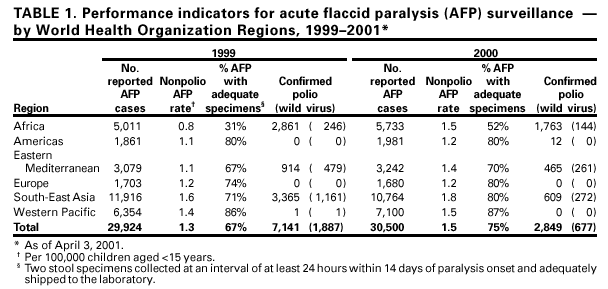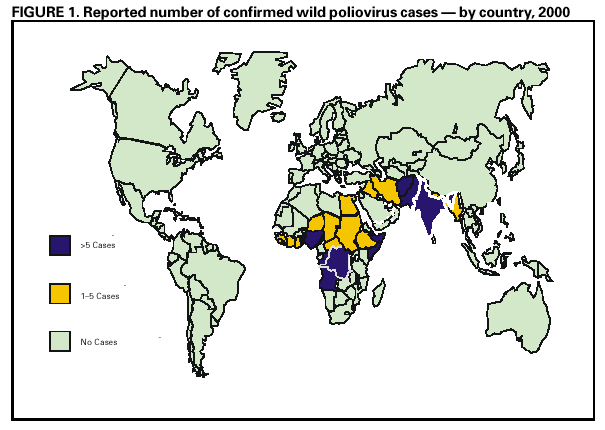 |
|
|
|
|
|
|
| ||||||||||
|
|
|
|
|
|
|
||||
| ||||||||||
|
|
|
|
|
Persons using assistive technology might not be able to fully access information in this file. For assistance, please send e-mail to: mmwrq@cdc.gov. Type 508 Accommodation and the title of the report in the subject line of e-mail. Progress Toward Global Poliomyelitis Eradication, 2000In 1988, the World Health Assembly resolved to eradicate poliomyelitis globally by 2000 (1). Substantial progress toward this goal has been reported from all six World Health Organization (WHO) regions*; 20 countries reported poliovirus transmission in December 2000 compared with 30 in 1999. WHO has prepared a global action plan that anticipates certification of polio eradication in 2005 (2). This report summarizes the status of the eradication effort and describes the remaining tasks to be completed to reach global polio eradication. Among infants aged <12 months worldwide, 79% and 78% were vaccinated with three doses of oral poliovirus vaccine (OPV) in 1998 and 1999, respectively. Africa reported the lowest routine vaccination rates (51% in 1998 and 49% in 1999). Among most of the 20 countries where polio is endemic (Figure 1), routine vaccination was <50%. Three activities supplement routine vaccination: national vaccination days (i.e., nationwide mass campaigns), subnational vaccination days (i.e., mass campaigns conducted in large areas of a country), and mopping-up (i.e., focal mass campaigns in high-risk areas). The supplemental rounds last several days to weeks and usually target children aged <5 years who are administered two OPV doses. Since 1999, countries where polio is endemic have increased the number and improved the quality of supplemental rounds; 10 priority countries held 50% more rounds in 2000 than in 1999, and an additional 10%--40% of children received OPV from health-care workers going house-to-house. During January 1999--May 2000, the number of countries where polio is endemic decreased from 30 to 24 (13 in Africa, seven in the Eastern Mediterranean, and four in the South-East Asia) (Figure 1). Transmission was detected in 20 countries during the second half of 2000. Despite improved surveillance, the number of reported polio cases decreased by 60% from 7141 in 1999 to 2849 as of April 3, 2001 (Table 1). From 1999 to 2000, the global nonpolio acute flaccid paralysis (AFP) rate, an indicator of surveillance sensitivity, increased from 1.3 per 100,000 population to 1.5, and the proportion of persons with AFP with adequate stool specimens increased from 67% to 75%. Type 2 wild poliovirus has not been detected since October 1999 (3). By late 2000, 128 (87%) of the 147 laboratories in the polio laboratory network had received WHO accreditation (i.e., attained a standardized quality level). The network processed 48,370 stool specimens in 1999 and approximately 50,000 in 2000 (3). To ensure consistent handling and results, all AFP specimens are processed in an accredited laboratory. At the end of 2000, <33% of the world's population lived in countries where polio was endemic, compared with >80% in 1988. Polio-free status has been certified in two of the six WHO regions: the Americas in 1994 and the Western Pacific in 2000. No wild polio-virus has been found in Europe since the last case reported from southeastern Turkey in 1998. All countries in a region must be free of wild poliovirus for 3 years as part of the certification requirements. During 2000--2001, an outbreak of vaccine-derived poliovirus was reported in the Americas: three laboratory-confirmed cases occurred in Haiti and 14 in the Dominican Republic (4,5). Infected persons were unvaccinated (n=six), inadequately vaccinated (n=five), adequately vaccinated (n=one), or their vaccination status was unknown (n=five). Genetic sequencing of the virus indicated that the outbreak was caused by vaccine-derived poliovirus type 1 that appeared to have acquired neurovirulence and transmission characteristics of wild poliovirus. The Dominican Republic and Haiti are completing three national vaccination rounds in 2001. In Africa in 2000, wild poliovirus transmission was reported mostly in central Africa and the Horn of Africa. Nigeria, the Democratic Republic of Congo (DRC), and Angola represent the largest poliovirus reservoirs. Nigeria reported 637 cases of which 11 were laboratory-confirmed. These 11 cases occurred throughout Nigeria, indicating that transmission was widespread. Following a large polio outbreak in 1999, Angola continued to detect virus transmission. The poliovirus type 1 responsible for the outbreak in Cape Verde originated in Angola (6). A polio outbreak also was reported from Congo-Brazzaville (31 confirmed wild poliovirus cases). DRC reported 513 cases, with 24 confirmed wild poliovirus cases found throughout the country, including border areas. In Ethiopia, three of 144 reported cases were laboratory-confirmed; however, transmission probably was underestimated because of the low quality of surveillance. In West Africa, the regional nonpolio AFP rate was 1.3 per 100,000 in 2000 compared with 0.8 per 100,000 in 1999. The proportion of persons in Africa with AFP from which adequate stool samples were collected increased from 31% in 1999 to 52% in 2000. House-to-house and nationwide vaccination rounds were conducted during the fall of 2000 and early 2001. In 2000, the Eastern Mediterranean reported 261 confirmed wild poliovirus cases. Wild poliovirus transmission remains widespread in Pakistan (173 cases) and Afghanistan (27 cases). Despite increasingly sensitive surveillance, Iraq has not detected wild poliovirus since January 2000. Sudan reported four confirmed wild poliovirus cases but surveillance is not sufficient to assess accurately the intensity of virus transmission. Improved surveillance in Somalia identified an outbreak of type 1 poliovirus (46 cases) in the Mogadishu area. During the first half of 2000, three confirmed wild poliovirus cases were reported from reservoirs in the governorates of Minya, Asyut, and Fayoum in upper Egypt. Wild poliovirus type 1 was detected in samples of sewage from Minya late in 2000; three confirmed wild poliovirus cases were reported in late 2000 and early 2001. South-East Asia reported 272 confirmed wild poliovirus cases in 2000 compared with 1161 cases in 1999. This decrease was attributable mainly to a decrease in the number of confirmed wild poliovirus cases reported from India where 265 cases were reported in 2000 compared with 1126 in 1999. India maintained high-quality surveillance, with a nonpolio AFP rate of 2.0 and adequate stool specimens collected from 83% of persons with AFP. Uttar Pradesh and Bihar in northern India remain the foci of poliovirus transmission along with a few scattered areas. During 2000, each campaign that targeted the >15 presumed virus reservoir outside northern India involved vaccinating approximately 1 million children aged <5 years. Despite improved surveillance, one wild poliovirus-associated case was reported in Bangladesh near Dhaka. However, virus sequence information suggested that transmission may not have been detected earlier in 2000. Myanmar reported two confirmed wild poliovirus cases near the border with Bangladesh, and Nepal reported four cases from its border with Uttar Pradesh and Bihar, India. Reported by: Vaccines and Biologicals Div, World Health Organization, Geneva, Switzerland. Enteric and Respiratory Viruses Br, Div of Viral and Rickettsial Diseases, National Center for Infectious Diseases; Vaccine Preventable Disease Eradication Div, National Immunization Program, CDC. Editorial Note:Progress toward interrupting wild poliovirus transmission, particularly in India, the largest country where polio is endemic, underscores the feasibility of eradication. The goal of interrupting transmission globally by the end of 2000 could not be achieved for several reasons, including delayed implementation of the polio eradication strategies in some regions, difficulties in accessing populations in war-torn countries, and slow progress toward raising the quality of both supplemental vaccination and surveillance. During 2000, progress toward eradication included a 60% decline in reported cases globally within 1 year, the certification of the Western Pacific as polio-free, the acceleration of activities in Africa as indicated by the 16 West African countries conducting synchronized national campaigns in the fall of 2000, and the public commitment to a polio-free world by international leaders and polio partners at the polio summit at the United Nations in September 2000. Challenges during 2000 included poliovirus importations from countries where polio is endemic to polio-free areas, which demonstrated the fragility of polio-free status and highlighted the importance of maintaining high polio vaccination coverage and certification-standard surveillance. The 17 deaths in Cape Verde associated with poliovirus imported from Angola underscore the severity of poliovirus infection even in areas that have been polio-free for years and the risk for transmission if population immunity is not maintained. On Hispaniola Island, the outbreak of vaccine-derived poliovirus would not have occurred had the population been vaccinated adequately; the outbreak confirms the need to maintain high vaccination coverage and sensitive AFP surveillance for early detection of and response to such outbreaks. During 2001, the major objective of the eradication process is to continue vaccination activities in countries where polio is endemic, including war-torn areas. Success will depend on negotiated cease-fires during vaccination rounds, enhanced access to all children, and the continued support of external partners†. References
* Africa, the Americas, Eastern Mediterranean, Europe, South-East Asia, and Western Pacific. † Includes polio-free countries and countries where polio is endemic, WHO, Rotary International, United Nations Children's Fund (UNICEF), CDC, other bilateral and multilateral partners, and private foundations. Table 1  Return to top. Figure 1  Return to top. Disclaimer All MMWR HTML versions of articles are electronic conversions from ASCII text into HTML. This conversion may have resulted in character translation or format errors in the HTML version. Users should not rely on this HTML document, but are referred to the electronic PDF version and/or the original MMWR paper copy for the official text, figures, and tables. An original paper copy of this issue can be obtained from the Superintendent of Documents, U.S. Government Printing Office (GPO), Washington, DC 20402-9371; telephone: (202) 512-1800. Contact GPO for current prices. **Questions or messages regarding errors in formatting should be addressed to mmwrq@cdc.gov.Page converted: 4/26/2001 |
|||||||||
This page last reviewed 5/1/2001
|